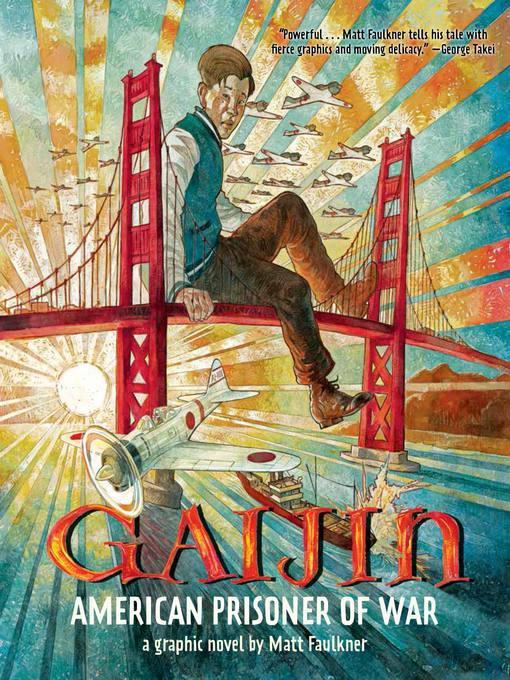
Gaijin--American Prisoner of War
فرمت کتاب
ebook
تاریخ انتشار
2020
Reading Level
0-1
ATOS
2.3
Interest Level
4-8(MG)
نویسنده
Matt Faulknerشابک
9781484712139
کتاب های مرتبط
- اطلاعات
- نقد و بررسی
- دیدگاه کاربران
نقد و بررسی

ikyra_marie - Good historical ficition book, so if you like historical fiction around the 1940's you should read it.

April 28, 2014
Faulkner (A Taste of Colored Water) draws on his own ancestry as inspiration for the story of 13-year-old Koji Miyamoto, a half-Japanese boy who is sent to an internment camp during WWII. Like many people of mixed race, Koji doesn't seem to fit in anywhereâharassed and called "slanty eyes" and a "Jap spy" by Americans after the bombing of Pearl Harbor, and a "gaijin" (a pejorative for foreigner) by the Japanese at the camp. Even with a loving mother and avuncular neighbor, Koji dreams of his father, who is abroad in Japan and whose absence places Koji under suspicion by the FBI. Aimless and filled with self-doubt, Koji begins to act out by committing petty theft and disrespecting authority, including his mother. Compassion becomes the key to Koji's salvation, and Faulkner's narrative elicits real pathos. Yet the book's true strength lies in its rich palette and painted visuals that, appropriately enough, evoke a mix between Japanese woodblock prints and Norman Rockwell paintings. Ages 8â12. Agent: Jennifer Laughran, Andrea Brown Literary Agency.

April 15, 2014
After the United States enters World War II, a half-Japanese teen and his white mother find themselves interned at the Alameda Downs Assembly Center. Everything changes for 13-year-old Koji Miyamoto after the Japanese attack on Pearl Harbor. His schoolmates accuse him of being a "Jap spy," and streetcars refuse to stop for him on the street. It doesn't help that his father has returned to Japan; Koji worries that his father may be fighting for the Japanese in the war. When Koji receives a summons to a "relocation" camp, his mother, Adeline, chooses to accompany him. The living conditions at Alameda Downs are deplorable, but Koji struggles even more with his outsider status. The other camp teenagers call him gaijin, involve him in brawls and spread gossip about his mother. Inspired by the true story of Faulkner's great-aunt, the graphic novel features gouache illustrations that deftly capture Koji's anger and frustration when he's rejected by his peers and treated as an "enemy alien" despite his citizenship. The simple text provides enough historical context to help young readers who may be unfamiliar with the history of Japanese-American internment to understand Koji's story. An accessible account about a dark--and still too-little-known--moment in American history. (author's note, resources) (Graphic historical fiction. 9-12)
COPYRIGHT(2014) Kirkus Reviews, ALL RIGHTS RESERVED.

May 1, 2014
Gr 5-8-In 1941, biracial Koji and his mother hear about the attacks on Pearl Harbor from their home in San Francisco. As tensions escalate, Mrs. Miyamoto volunteers to accompany her son to the Japanese relocation camp, where Koji has to navigate the hostile environment and the social pressures of the other teenage boys. Throughout all this, his father is absent, and Koji worries if he is the traitor the U.S. government suspects him to be. The artwork is lovely, with gestural lines and colors that are warm and redolent of age and memory, and which bridge caricature and realism. However, the dialogue and word balloons lack a similar finesse, as they are garishly large and convey little subtlety of emotion. They make the protagonist seem loud and immature, and generally pitch the book younger than his age. This is problematic, as he is old enough to worry about his mother, and harbors suspicions that she is having affairs for favorable treatment in the camp-issues somewhat beyond the scope of a children's book. Emotions at the times ran high, and the issues depicted are complex; this book doesn't quite capture that complexity.-Benjamin Russell, Belmont High School, NH
Copyright 2014 School Library Journal, LLC Used with permission.

April 15, 2014
Grades 6-10 Koji is living with his white mother in San Francisco when Japanese planes attack Pearl Harbor, and almost immediately, they are accused of being spies. Life as a half Japanese teenager in San Francisco was hard enough, but once Koji and his mother are sent to Alameda Downs, an internment camp, he finds he is still an outsider and subject to more racial slurs, this time from other Japanese boys. Railing against the white soldiers who fawn over his mother, and the ragtag bullies who beat him up and rope him in to doing their dirty work, Koji doesn't know where to turn. The sparse text lends little in the way of depth, but Faulkner's painterly cross-hatched watercolor artwork fills in the gaps with sweeping maps, detailed backgrounds depicting the conditions at Alameda, and exaggerated, caricature-like expressions on his characters, many of whom loom large during intense moments and spill over the boundaries of their panels. An author's note about the inspiration for the storyFaulkner's Irish great-aunt spent time at Manzanarand some further reading suggestions conclude.(Reprinted with permission of Booklist, copyright 2014, American Library Association.)

























دیدگاه کاربران